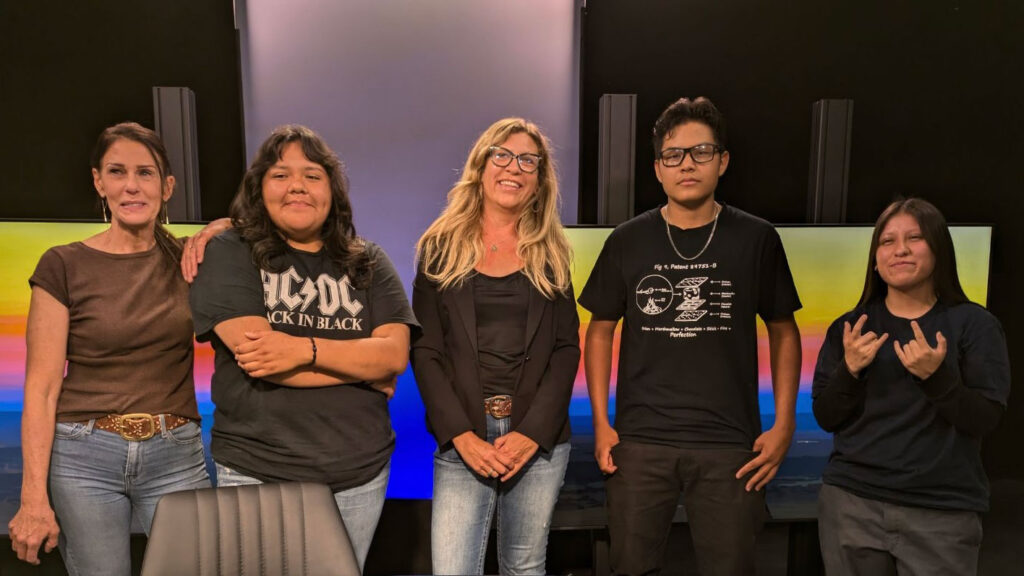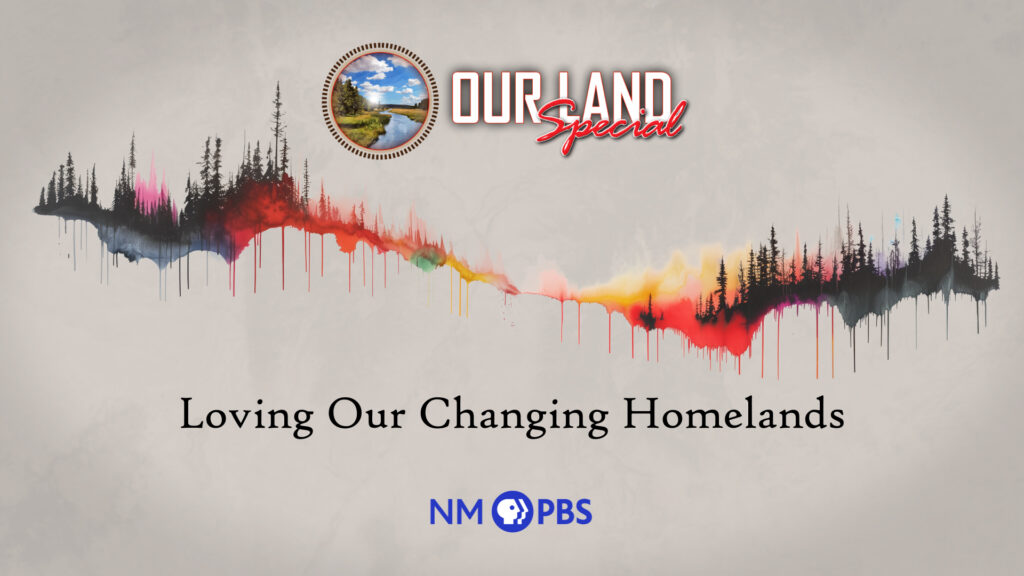Minimizing Harm

Earlier this year, tenth graders from Thoreau High School wrote to media outlets and officials across the state, drawing attention to a recommended cleanup plan from the federal government. Across the Navajo Nation, contaminated uranium mines have been polluting the air and water and making people sick for generations. As part of a plan to finally clean up more than a million cubic yards of contaminated uranium and radium waste at just one of those sites, the U.S. Environmental Protection Agency has proposed relocating the waste to private land within the town of Thoreau. Relocating it to the Red Rocks Disposal Facility would move the uranium off the lands of the Navajo Nation, but as the students point out, the town of Thoreau is predominantly Navajo.
This spring, a representative from the EPA met with the students, who listened to a presentation and interviewed him for their podcast. I visited Thoreau High School in May and then invited the teens into the studio in Albuquerque to talk about what they’re learning, and who they’re hoping will listen. This week, please tune in to the show to hear from Reagan Russette, MiaBella Burrola, and Ezekiel Gonzales.
I haven’t gone down to Ruidoso yet, so I don’t feel qualified to write about the fires or their aftermath. Instead, I’ll point you toward coverage from Source NM (whose reporters are doing excellent and thoughtful work) as well as the Village of Ruidoso’s South Fork/Salt Fire Information Hub and the State of New Mexico’s 2024 Wildfire page. I’ve included some other resources from the state at the end of this email.
Last week, during the fire’s most devastating run, social media was awash with videos of fire, smoke, and destroyed homes.
It reminded me of how, in 2022, when people were losing their homes and homelands in the Hermits Peak-Calf Canyon Fire, I remember hearing how devastating it was for people to see their beloved homes and ranches on the news and on social media. I remember hearing how people felt violated and traumatized.
And last week, I spoke with a friend whose wife couldn’t look away from the feeds showing burned homes, as she looked to see if her family home was among them. With each news reel (or social media reel), she was sick, wondering if she’d see her home next.
In 2022, after the Hermits Peak-Calf Canyon Fire, I invited two special reporters, Adria Malcolm and Patrick Lohmann, to talk to me about their coverage. You can watch the entire interview on NMPBS, but I also pulled out a snippet during which Malcolm, a photojournalist, acknowledges the extractive nature of journalism and talks about the respect she brings to her work.
I totally understand that it is dramatic (and clickbaity) to share fire and destruction footage on social media. Many journalists do their best to acknowledge the harm that reporting can sometimes do. As professionals, we also should adhere to a code of ethics. There’s no reason that non-journalists can’t bring the same care to their community members in a time of crisis, too. I know everyone is trying to drive traffic to their sites, pages, feeds, and social media accounts. But it’s totally possible to bring accurate and important information to the public without exploiting or traumatizing people.
Now, for some of the news:
• “Extreme Wildfires Have Doubled in 2 Decades, Study Finds” (Austyn Gaffney, The New York Times)
• “U.S. Supreme Court rejects NM and Texas deal on Rio Grande” (Danielle Prokop, Source NM)
• “The Human Toll of Nuclear Testing” (W.J. Hennigan, The New York Times)
• “Taos Canyon proposed for thinning, Rx burns” (Geoffrey Plant, Taos News)
• “BLM looks at controlled burns near Pinos Altos” (Juno Ogle, Silver City Daily Press)
• “A small bite that can carry serious consequences” (Cindy Brown, Taos News)
• “Inside Big Oil’s Business as Usual: Failure on Climate and Profits from War” (Stella Levantesi, DeSmog)
Things I loved, just because:
• “Inside the Slimy, Smelly, Secretive World of Glass-Eel Fishing” (Paige Williams, The New Yorker)
• “The Mysterious, Deep-Dwelling Microbes That Sculpt Our Planet” (Ferris Jabr, The New York Times Magazine)
• “Luis Alberto Urrea: On Our Belonging to Each Other” (OnBeing with Krista Tippett)
And, get ready because I’m super excited about a show coming up next month, “Loving Our Changing Homelands.” It airs on July 12, and I’ll have more information next week.

All of this information is from the State of New Mexico:
• A state Disaster Recovery Center is now open at the Roswell Convention Center and will remain open seven days a week from 8 a.m. to 6 p.m. Residents can get connected to Disaster Case Management and receive help coordinating both short- and long-term resources.
• The center can also help with: applications for SNAP benefits and other assistance programs, Unemployment, WIC, insurance claims or checking on policies, additional living expense payments, help getting documents for existing Medicaid policies, applying for Medicaid, and peer support.
• Applications for Federal Disaster Assistance are now open. Individuals in Lincoln County and the Mescalero Apache Tribe can apply online at www.DisasterAssistance.gov or call the FEMA application helpline at (800) 621-3362. Calls are accepted daily from 6 a.m. to 10 p.m. Mountain Time.
• Serious Needs Assistance (SNA) provides funding for households to cover important items like water, food, first aid, breast-feeding supplies, infant formula, diapers, personal hygiene items, and fuel for transportation or other emergency supplies for eligible households. To qualify for SNA, you must be displaced, need shelter or have other emergency costs due to the disaster on your application.
• Displacement Assistance (DA) provides people with up-front funds to assist with immediate housing options of their choice, to keep people housed. The money can be used to stay in a hotel, with family and friends or other options.
• For those who cannot or do not wish to go to the Disaster Recovery Center, the following are resources available and how to get information or apply by calling the state’s 24/7 Fire Hotline at 1-833-663-4736 or visit dhsem.nm.gov/nmwildfires.
• Disaster Unemployment Assistance (DUA) is available to individuals whose employment or self-employment was lost or interrupted as a direct result of the 2024 wildfires in the areas of Lincoln County, Otero County, and the Mescalero Apache Tribe. An individual must first apply for Standard Unemployment Insurance. This may be done online anytime 24/7 at https://www.jobs.state.nm.us, in person at any Workforce Connection Center, or by calling the Unemployment Insurance Operations center at 1-877-664-6984, Monday through Friday, 8 a.m.- 4:30 p.m. Claimants filing their standard unemployment insurance claim online should be sure to check the box indicating that they have been affected by the fires. After an individual receives notice that they are not eligible for Standard Unemployment Insurance, they may then apply for Disaster Unemployment Assistance by calling the Unemployment Insurance Operations Center or by coming in person to any New Mexico Workforce Connection Center. As a fraud prevention measure, DUA applications are only accepted in person or by phone. Individuals who are applying in person for DUA may go to any New Mexico Workforce Connection Center to speak with an NMDWS representative Monday through Friday 8 a.m.- 5 p.m.
P.S. If a friend forwarded you this message, sign up here to receive the newsletter yourself. You can also read recent newsletters online. And if you miss us throughout the week, follow Our Land on Instagram.


